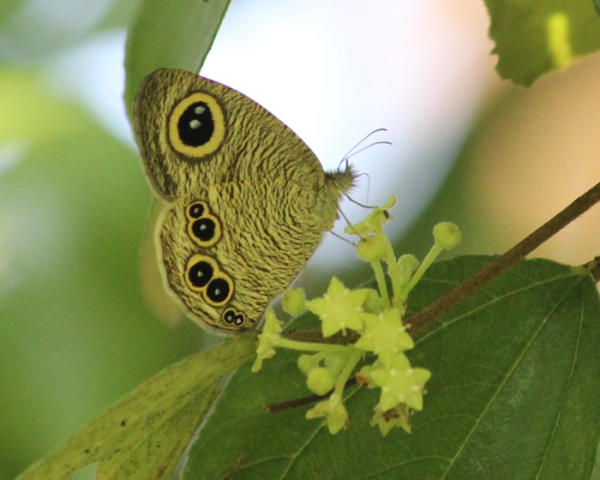Butterfly diversity (Lepidoptera: Rhophalocera) associated with nectar feeding on Ziziphus mauritiana Lamarck (Rosales: Rhamnaceae) flowers in Chuadanga, Bangladesh
Main Article Content
Abstract
A study was conducted during the flowering season of Ziziphus mauritiana from September 2015 to October 2015 in Belgachi Railgate Para, Chuadanga, Bangladesh. The study recorded 265 individuals of 39 butterfly species belonging to five families and 32 genera nectar feeding on Z. mauritiana flowers. Amongst the families, Lycaenidae was dominant with 33.33% (n=13). Amongst the species Parnara bada (Moore, 1878) (Hesperiidae) was the most dominant species followed by Ypthima baldus (Fabricius, 1775) (Nymphalidae). Virachola isocrates (Fabricius, 1793) (Lycaenidae) spent the maximum time (60–120 sec) nectar feeding on Z. mauritiana amongst the 39 species sampled.
Article Details
Authors own the copyright to the articles published in JoTT. This is indicated explicitly in each publication. The authors grant permission to the publisher Wildlife Information Liaison Development (WILD) Society to publish the article in the Journal of Threatened Taxa. The authors recognize WILD as the original publisher, and to sell hard copies of the Journal and article to any buyer. JoTT is registered under the Creative Commons Attribution 4.0 International License (CC BY), which allows authors to retain copyright ownership. Under this license the authors allow anyone to download, cite, use the data, modify, reprint, copy and distribute provided the authors and source of publication are credited through appropriate citations (e.g., Son et al. (2016). Bats (Mammalia: Chiroptera) of the southeastern Truong Son Mountains, Quang Ngai Province, Vietnam. Journal of Threatened Taxa 8(7): 8953–8969. https://doi.org/10.11609/jott.2785.8.7.8953-8969). Users of the data do not require specific permission from the authors or the publisher.
References
Ashraf, A., R.A. Sarfraz, F. Anwar, S.A. Shahid & K.M. Alkharfy (2015). Chemical composition and biological activities of leaves of Ziziphus mauritiana L native to Pakistan. Pakistan Journal of Botany 47(1): 367–376.
Begum, M., U. Habiba & M.A. Howlader (2014). Nectar feeding behavior of some butterflies in the botanical garden of Dhaka University. Bangladesh Journal of Zoology 42(1): 85–90; http://doi.org/10.3329/bjz.v42i1.23339
Corbet, S.A. (2000). Butterfly nectaring flowers: butterfly morphology and flower form. Entomologia Experimentalis Applicata 96(3): 289–298.
DeVries, P.J., T.R. Walla & H.F. Greeney (1999). Species diversity in spatial and temporal dimensions of fruit - feeding butterflies from two Ecuadorian rainforests. Biological Journal of the Linnean Society 68: 333–353.
Dosa, G. (1999) Flower visitation patterns of butterflies and burnet moths in the Aggtelek-Karst. Nota Lepidopterologica 22(1): 58–66.
Gillespie, M. & S.D. Wratten (2013). Enhancing nectar provision in vineyard habitats for the endemic New Zealand butterfly, Lycaena salustius. New Zealand Ecological Society 37(1): 67–74.
Jennersten, O. (1984). Flower visitation and pollination efficiency of some north European butterflies. Oecologia 63(1): 80–89.
Jolivet, P. (1986). Insects and Plants. Flora And Fauna Hand Book, No. 2. E.J. Brill Flora and Fauna Publications, USA.
Kehimkar, I. (2008). The Book of Indian Butterflies. Bombay Natural History Society, 497pp.
Kunte, K. (2000). Butterflies of Peninsular India. Universities Press Private Limited, Hyderabad, India, 270pp.
Mishra, R.M., P. Gupta & G.P. Yadav (2004). Intensity and diversity of flower-visiting insects in relation to plant density of Zizyphus mauritiana Lamk. Tropical Ecology 45(2): 263–270.
Ômura, H. & K. Honda (2005). Priority of color over scent during flower vegetation by adult Venessa indica butterflies. Oecologia 142(4): 588–596.
Orwa, C., A. Mutua, R. Kindt, R. Jamnadass & S. Anthony (2009). Ziziphus mauritiana. Agroforestree Database:a tree reference and selection guide version 4.0
http://www.worldagroforestry.org/sites/treedbs/treedatabases.asp.
Downloaded on 18 January 2016.
Porter, K., C.A. Steel & J.A. Thomas (1992). Butterflies and communities, pp. 139–177. In: Dennis, R.L.H. (eds.). The Ecology of Butterflies in Britain. University Press, Oxford, New York, Tokyo.
Sellers, B. (2014). Biology and Control of Indian Jujube (Ziziphus mauritiana): A Weed to Watch in Florida Pastures and Natural Areas. IFAS Extension Service, University of Florida, IFAS, Florida, 3pp.
Shihan, T.R. (2016). Records of some butterflies from Chuadanga, Bangladesh. Zoo’s Print XXXI(3): 9–11.
Sourakov, A., A. Duehl & A. Sourakov (2012). Foraging behavior of the blue morpho and other tropical butterflies: The chemical and electrophysiological basis of olfactory preferances and the role of color. Psyche 1–10; http://doi.org/10.1155/2012/378050
Varshney, R.K. & Smetacek, P. (eds.) (2015). A Synoptic Catalogue of the Butterflies of India. Butterfly Research Centre, Bhimtal and Indinov Publishing, New Delhi, 261pp.
Weiss, M.R. (1997). Innate colour preferences and flexible colour learning in the pipevine swallowtail. Animal Behaviour 53(5): 1043–1052.

